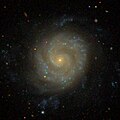| NGC 3596 | |
|---|---|
 NGC 3596 imaged by the Hubble Space Telescope | |
| Observation data (J2000 epoch) | |
| Constellation | Leo |
| Right ascension | 11h 15m 06.2152s [1] |
| Declination | +14° 47′ 13.404″ [1] |
| Redshift | 0.003979±0.000002 [1] |
| Heliocentric radial velocity | 1,193±1 km/s [1] |
| Distance | 57.24 ± 6.82 Mly (17.550 ± 2.092 Mpc) [1] |
| Apparent magnitude (V) | 12.0 [1] |
| Characteristics | |
| Type | SAB(rs)c [1] |
| Size | ~74,900 ly (22.97 kpc) (estimated) [1] |
| Apparent size (V) | 4.0′ × 3.8′ [1] |
| Other designations | |
| UGC 6277, MCG +03-29-013, PGC 34298, CGCG 096-013 [1] | |
NGC 3596 is an intermediate spiral galaxy in the constellation Leo. It was discovered by German-British astronomer William Herschel on 8 April 1784. [2] It is located below the star Theta Leonis (Chertan). [3] It is a member of the Leo II Groups, a series of galaxies and galaxy clusters strung out from the right edge of the Virgo Supercluster. [4]


